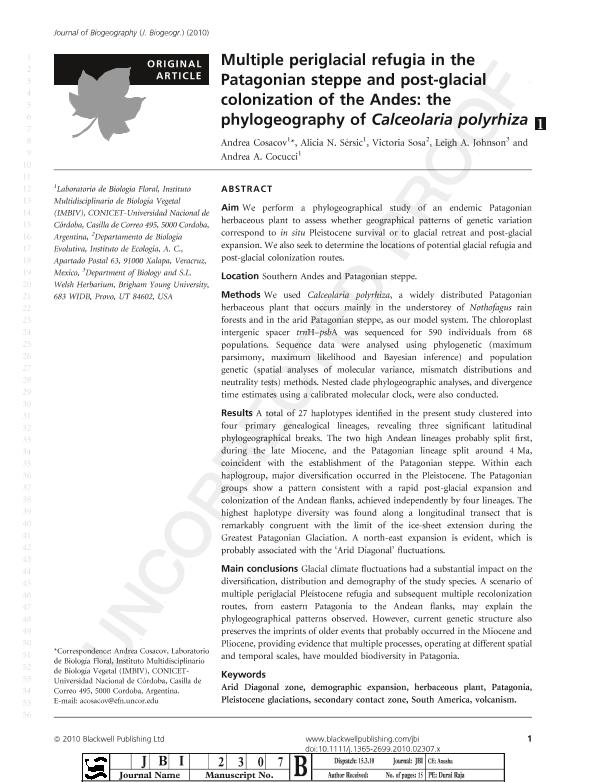Mostrar el registro sencillo del ítem
dc.contributor.author
Cosacov Martinez, Andrea

dc.contributor.author
Sersic, Alicia Noemi

dc.contributor.author
Sosa, Victoria
dc.contributor.author
Johnson, Leigh A.
dc.contributor.author
Cocucci, Andrea Aristides

dc.date.available
2017-03-14T16:28:11Z
dc.date.issued
2010-09
dc.identifier.citation
Cosacov Martinez, Andrea; Sersic, Alicia Noemi; Sosa, Victoria; Johnson, Leigh A.; Cocucci, Andrea Aristides; Multiple periglacial refugia in the Patagonian steppe and post-glacial colonization of the Andes: the phylogeography of Calceolaria polyrhiza; Wiley; Journal Of Biogeography; 37; 8; 9-2010; 1463-1477
dc.identifier.issn
0305-0270
dc.identifier.uri
http://hdl.handle.net/11336/13840
dc.description.abstract
Aim We perform a phylogeographical study of an endemic Patagonian herbaceous plant to assess whether geographical patterns of genetic variation correspond to in situ Pleistocene survival or to glacial retreat and post-glacial expansion. We also seek to determine the locations of potential glacial refugia and post-glacial colonization routes.
Location Southern Andes and Patagonian steppe.
Methods We used Calceolaria polyrhiza, a widely distributed Patagonian herbaceous plant that occurs mainly in the understorey of Nothofagus rain forests and in the arid Patagonian steppe, as our model system. The chloroplast intergenic spacer trnH–psbA was sequenced for 590 individuals from 68 populations. Sequence data were analysed using phylogenetic (maximum parsimony, maximum likelihood and Bayesian inference) and population genetic (spatial analyses of molecular variance, mismatch distributions and neutrality tests) methods. Nested clade phylogeographic analyses, and divergence time estimates using a calibrated molecular clock, were also conducted.
Results A total of 27 haplotypes identified in the present study clustered into four primary genealogical lineages, revealing three significant latitudinal phylogeographical breaks. The two high Andean lineages probably split first, during the late Miocene, and the Patagonian lineage split around 4 Ma, coincident with the establishment of the Patagonian steppe. Within each haplogroup, major diversification occurred in the Pleistocene. The Patagonian groups show a pattern consistent with a rapid post-glacial expansion and colonization of the Andean flanks, achieved independently by four lineages. The highest haplotype diversity was found along a longitudinal transect that is remarkably congruent with the limit of the ice-sheet extension during the Greatest Patagonian Glaciation. A north-east expansion is evident, which is probably associated with the ‘Arid Diagonal’ fluctuations.
Main conclusions Glacial climate fluctuations had a substantial impact on the diversification, distribution and demography of the study species. A scenario of multiple periglacial Pleistocene refugia and subsequent multiple recolonization routes, from eastern Patagonia to the Andean flanks, may explain the phylogeographical patterns observed. However, current genetic structure also preserves the imprints of older events that probably occurred in the Miocene and Pliocene, providing evidence that multiple processes, operating at different spatial and temporal scales, have moulded biodiversity in Patagonia.
dc.format
application/pdf
dc.language.iso
eng
dc.publisher
Wiley

dc.rights
info:eu-repo/semantics/openAccess
dc.rights.uri
https://creativecommons.org/licenses/by-nc-sa/2.5/ar/
dc.subject
Arid Diagonal Zone
dc.subject
Demographic Expansion
dc.subject
Herbaceous Plant
dc.subject
Patagonia
dc.subject
Pleistocene Glaciations
dc.subject
Secondary Contact Zone
dc.subject
South America
dc.subject
Volcanism
dc.subject.classification
Ciencias de las Plantas, Botánica

dc.subject.classification
Ciencias Biológicas

dc.subject.classification
CIENCIAS NATURALES Y EXACTAS

dc.title
Multiple periglacial refugia in the Patagonian steppe and post-glacial colonization of the Andes: the phylogeography of Calceolaria polyrhiza
dc.type
info:eu-repo/semantics/article
dc.type
info:ar-repo/semantics/artículo
dc.type
info:eu-repo/semantics/publishedVersion
dc.date.updated
2017-03-13T13:29:55Z
dc.identifier.eissn
1365-2699
dc.journal.volume
37
dc.journal.number
8
dc.journal.pagination
1463-1477
dc.journal.pais
Reino Unido

dc.journal.ciudad
Londres
dc.description.fil
Fil: Cosacov Martinez, Andrea. Consejo Nacional de Investigaciones Científicas y Técnicas. Centro Científico Tecnológico Córdoba. Instituto Multidisciplinario de Biología Vegetal (p); Argentina
dc.description.fil
Fil: Sersic, Alicia Noemi. Consejo Nacional de Investigaciones Científicas y Técnicas. Centro Científico Tecnológico Córdoba. Instituto Multidisciplinario de Biología Vegetal (p); Argentina
dc.description.fil
Fil: Sosa, Victoria. Instituto de Ecologia; México
dc.description.fil
Fil: Johnson, Leigh A.. Brigham Young University. Department of Biology and S.L. Welsh Herbarium; Estados Unidos
dc.description.fil
Fil: Cocucci, Andrea Aristides. Consejo Nacional de Investigaciones Científicas y Técnicas. Centro Científico Tecnológico Córdoba. Instituto Multidisciplinario de Biología Vegetal (p); Argentina
dc.journal.title
Journal Of Biogeography

dc.relation.alternativeid
info:eu-repo/semantics/altIdentifier/url/http://onlinelibrary.wiley.com/doi/10.1111/j.1365-2699.2010.02307.x/abstract
dc.relation.alternativeid
info:eu-repo/semantics/altIdentifier/doi/http://dx.doi.org/doi:10.1111/j.1365-2699.2010.02307.x
Archivos asociados
